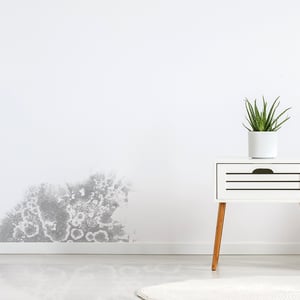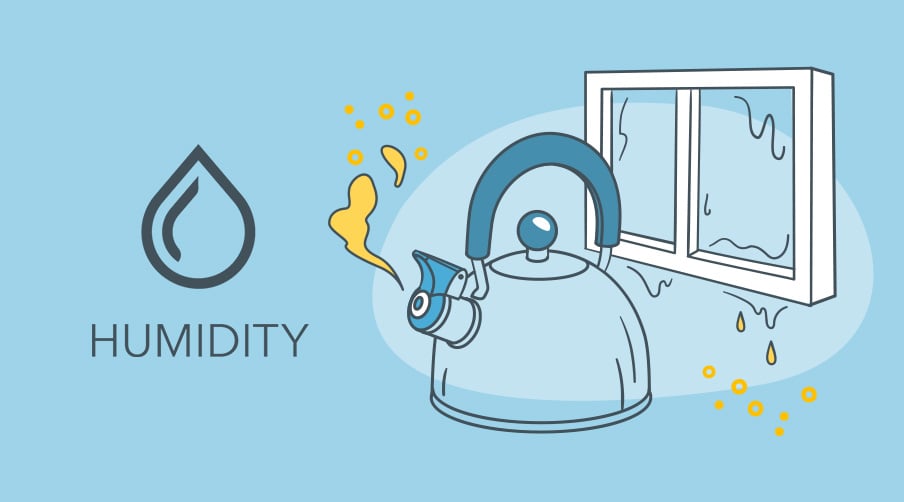High levels of moisture in the air can damage buildings, trigger asthma and allergies, and encourage the growth of mold and dust mites, which can also worsen asthma. At the other extreme, low humidity can boost the spread of infections. As well as creating health hazards contributing to sickness and absence, humidity problems increase the risk of damage to buildings. Since people spend approximately 90% of their time indoors1, monitoring humidity is fundamental for commercial buildings like schools and offices.
What is humidity?
Humidity is a measure of the amount of water vapor in the air which represents a natural part of our atmosphere. However, humidity indoors can lead to different undesirable conditions for buildings and its occupants.
.png?width=614&name=humidity%20header%20image%20%20(1).png)

What are the effects of humidity on commercial buildings and their occupants?
-
Spread of infections and absenteeism:
 Low humidity can boost the spread of infections. Indeed, some studies showed that when absolute humidity is low, viruses in the air survive longer and transmission rates increase.2 This could increase absenteeism rates in commercial buildings, such as schools and offices.
Low humidity can boost the spread of infections. Indeed, some studies showed that when absolute humidity is low, viruses in the air survive longer and transmission rates increase.2 This could increase absenteeism rates in commercial buildings, such as schools and offices.
Various studies have shown that by increasing humidity levels indoors we can reduce the infectivity of influenza virus particles. Indeed, researchers found that an hour after being released in a room at a relative humidity of 23% or less, up to 77% of viral particles were still able to infect. 3
However, when humidity was increased to about 43%, only 14% of the virus particles were capable of infecting cells. 4 Maintaining indoor relative humidity >40% will significantly reduce the infectivity of viruses in the air. 5
Monitoring humidity can then help commercial buildings contain virus spread and sick leave.
-
Damage to buildings caused by mold:
 Extremely high levels of humidity increase the risk of damage to buildings. Indeed, fungi, bacteria and other microorganisms can also grow on the structural parts of a building if the relative humidity inside the building reaches 70% or more, while dust mites can multiply in furnishings. 11
Extremely high levels of humidity increase the risk of damage to buildings. Indeed, fungi, bacteria and other microorganisms can also grow on the structural parts of a building if the relative humidity inside the building reaches 70% or more, while dust mites can multiply in furnishings. 11
The results of a study showed that inadequate humidity control has resulted in thermal discomfort and mold contamination so great as to make some buildings uninhabitable. 12 In fact, excess moisture or water may penetrate into the ceilings, walls, floors or furnishings through seepage, leakage or condensation of atmospheric water vapour. Microbial growth then starts immediately, leading to deterioration of building materials and decreasing overall air quality. 13 Monitoring humidity is then essential to contain building damage.
-
High humidity can cause mold and dust mites:
 Mold is addressed in specific Occupational Safety and Health Administration (OSHA) standards for general industry, shipyard employment and construction. Similarly, in Europe, the European Agency for Safety and Health at Work also regulate mold in the workplace. As we all know, high humidity can cause this mold growth.
Mold is addressed in specific Occupational Safety and Health Administration (OSHA) standards for general industry, shipyard employment and construction. Similarly, in Europe, the European Agency for Safety and Health at Work also regulate mold in the workplace. As we all know, high humidity can cause this mold growth.
Not only does mold damage the building itself, but it can also have a negative impact on the health of employees.
Rates of allergies have risen sharply in the last 20 years. According to Allergy UK, 44% of adults in the UK suffer from one or more types of allergy. 6 Humidity indoors is the most important factor in determining the growth of mold and dust mites 7, which are two of the main contributors to allergy symptoms 8, as well as having consequences on the building itself.
Monitoring humidity can then help reduce the allergy symptoms for building occupants in all commercial buildings, like schools and offices.
-
Asthma is impacted by humidity:
 High levels of humidity in the air have been known to trigger asthma. Indeed, it has been shown that breathing in hot, humid air triggered consistent coughs in patients with mild asthma. 9
High levels of humidity in the air have been known to trigger asthma. Indeed, it has been shown that breathing in hot, humid air triggered consistent coughs in patients with mild asthma. 9
Not surprisingly, the results of another study conducted in Western Europe shows that the number of cases of asthma increased by 2.7% with an increase in the annual mean of indoor relative humidity of 10%.10 Monitoring humidity can then help contain asthma attacks in commercial buildings like schools and offices.
Airthings recommends indoor humidity levels in the range from 30% to 60%. By keeping an eye on humidity levels, you will be alerted and able to take timely action, reducing the costs to your organization.

Sources
1 Harvard Annual review of public https://www.annualreviews.org/doi/10.1146/annurev-publhealth-031816-044420
2 https://www.sciencedaily.com/releases/2009/02/090209205148.htm
3 https://www.sciencedaily.com/releases/2013/02/130227183456.htm (John D. Noti, Francoise M. Blachere, Cynthia M. McMillen, William G. Lindsley, Michael L. Kashon, Denzil R. Slaughter, Donald H. Beezhold. High Humidity Leads to Loss of Infectious Influenza Virus from Simulated Coughs. PLoS ONE, 2013; 8 (2): e57485 DOI: 10.1371/journal.pone.0057485)
4 https://www.sciencedaily.com/releases/2013/02/130227183456.htm (John D. Noti, Francoise M. Blachere, Cynthia M. McMillen, William G. Lindsley, Michael L. Kashon, Denzil R. Slaughter, Donald H. Beezhold. High Humidity Leads to Loss of Infectious Influenza Virus from Simulated Coughs. PLoS ONE, 2013; 8 (2): e57485 DOI: 10.1371/journal.pone.0057485)
5 https://journals.plos.org/plosone/article?id=10.1371/journal.pone.0057485
6 https://www.allergyuk.org/information-and-advice/statistics
7 https://www.lung.org/clean-air/at-home/indoor-air-pollutants/dust-mites
8 https://www.sciencedaily.com/releases/2008/03/080326194314.htm
9 https://www.sciencedaily.com/releases/2012/06/120606164934.htm
10 https://www.who.int/ceh/capacity/respiratory.pdf
11 http://www.euro.who.int/__data/assets/pdf_file/0005/156146/WA754ES.pdf
12 https://www.epa.gov/indoor-air-quality-iaq/indoor-air-quality-and-energy-efficiency
13 http://www.euro.who.int/__data/assets/pdf_file/0005/156146/WA754ES.pdf
 Most popular
Most popular
 NEW
NEW




 Radon
Radon
 Radon
Radon


.webp)



.png?width=614&name=humidity%20header%20image%20%20(1).png)
 Low humidity can boost the spread of infections. Indeed, some studies showed tha
Low humidity can boost the spread of infections. Indeed, some studies showed tha Extremely high levels of humidity increase the risk of damage to buildings. Indeed, fungi, bacteria and other microorganisms can also grow on the structural parts of a building if the relative humidity inside the building reaches 70% or more, while dust mites can multiply in furnishings. 11
Extremely high levels of humidity increase the risk of damage to buildings. Indeed, fungi, bacteria and other microorganisms can also grow on the structural parts of a building if the relative humidity inside the building reaches 70% or more, while dust mites can multiply in furnishings. 11
 High levels of humidity in the air have been known to trigger asthma. Indeed, it has been shown that breathing in hot,
High levels of humidity in the air have been known to trigger asthma. Indeed, it has been shown that breathing in hot, 